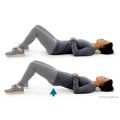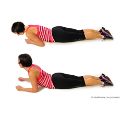Actionset
Overview
- Low back pain is very common among adults and is often caused by overuse and muscle strain or injury. Treatment can help you stay as active as possible. And it will help you understand that some continued or repeated back pain is not surprising or dangerous.
- Most low back pain can get better if you stay active, avoid positions and activities that may increase or cause back pain, use ice, and take non-prescription pain relievers when you need them.
- When you no longer have acute pain, you may be ready for gentle strengthening exercises for your stomach, back, and legs, and perhaps for some stretching exercises. Exercise may not only help decrease low back pain, but it may also help you recover faster, prevent reinjury to your back, and reduce the risk of disability from back pain.
- Exercises to reduce low back pain are not complicated and can be done at home without any special equipment.
- It's important that you don't let fear of pain keep you from trying gentle activity. You should try to be active soon after noticing pain, and gradually increase your activity level. Too little activity can lead to loss of flexibility, strength, and endurance, and then to more pain.
How do I exercise to reduce low back pain?
Most people who have back pain naturally feel better by doing certain motions. Some feel better sitting (their back and hips are flexed). Others feel better standing (back and hips are extended). Exercise that moves you toward your more comfortable position is usually more successful in treating your back pain.footnote 1 For example, if you are more comfortable sitting down, exercises that bend you forward—such as partial sit-ups (curl-ups) and knee-to-chest exercises—may help you.
Talk to your doctor before you start an exercise program, and only do exercises that do not increase your symptoms.
The most effective exercise programs for chronic low back pain are designed specifically for you and are supervised.footnote 2 For example, a physiotherapist might teach you an exercise program that you can use at home. Then you would see the therapist every so often to check on your progress and advance your program.
- Talk to your doctor or physiotherapist if you are unsure how to do these exercises or if you feel any pain when you are doing the exercises.
- Try to exercise a little bit every day.
- Get some type of aerobic exercise, such as walking, every day. Even a couple of minutes will be helpful, and you can gradually increase your time.
- Choose a couple of stretching and strengthening exercises that you enjoy doing, or vary them from day to day.
Ask your doctor or physiotherapist whether there are additional exercises that will work best for you.
Exercises to try if your back pain is eased by standing or lying down:
Exercises to try if your back pain is eased by sitting down:
Exercises to try when no position eases your back pain:
References
Citations
- Long A, et al. (2004). Does it matter which exercise? Spine, 29(23): 2593–2602.
- Hayden JA, et al. (2005). Systematic review: Strategies for using exercise therapy to improve outcomes in chronic low back pain. Annals of Internal Medicine, 142(9): 776–785.
Credits
Current as of: March 1, 2023
Author: Healthwise Staff
Medical Review:
William H. Blahd Jr. MD, FACEP - Emergency Medicine
Brian D. O'Brien MD - Internal Medicine
Adam Husney MD - Family Medicine
Kathleen Romito MD - Family Medicine
Joan Rigg PT, OCS - Physical Therapy
Current as of: March 1, 2023
Author: Healthwise Staff
Medical Review:William H. Blahd Jr. MD, FACEP - Emergency Medicine & Brian D. O'Brien MD - Internal Medicine & Adam Husney MD - Family Medicine & Kathleen Romito MD - Family Medicine & Joan Rigg PT, OCS - Physical Therapy






















